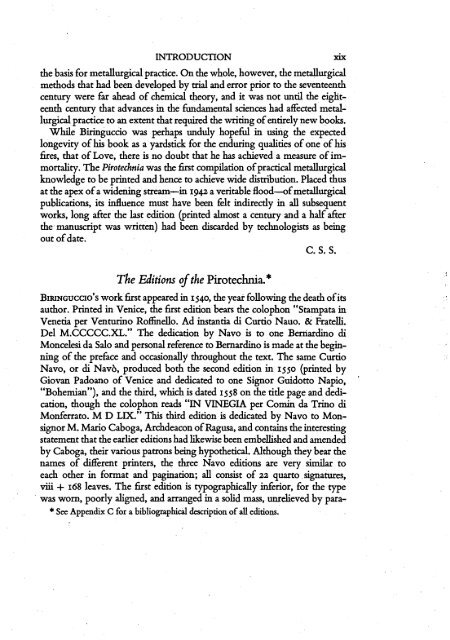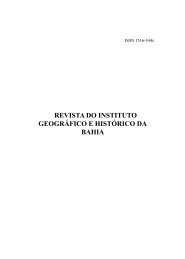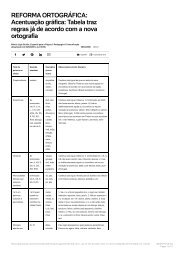Livro - Biringuccio - 09-1002-0
Artilharia os primórdios
Artilharia os primórdios
You also want an ePaper? Increase the reach of your titles
YUMPU automatically turns print PDFs into web optimized ePapers that Google loves.
INTRODUCTION<br />
the basis for metallurgical practice. On the whole, however, the metallurgical<br />
methods that had been developed by mal and error prior to the seventeenth<br />
century were far ahead of chemical theory, and it was not until the eigliteenth<br />
century that advances in the fundamental sciences had affected metallurgical<br />
practice to an extent that required the writing of entirely new books.<br />
While <strong>Biringuccio</strong> was perhaps unduly hopeful in using the expected<br />
longevity of his book as a yardstick for the enduring qualities of one of his<br />
fires, that of Love, there is no doubt that he has achieved a measure of immortality.<br />
The Pirotechnia was the first compilation of practical metallurgical<br />
knowledge to be printed and hence to achieve wide dismbution. Placed thus<br />
at the apex of a widening stream-in 194 a veritable flood-f metallurgical<br />
publications, its influence must have been felt indirectly in all subsequent<br />
works, long after the last edition (printed almost a century and a half her<br />
the manuscript was written) had been discarded by technologists as being<br />
out of date.<br />
C. S. S.<br />
xix<br />
The Editions ofthe Pirotechma. *<br />
BIRINGUCCIO'S work first appeared in 1540, the year following the death of its<br />
author. Printed in Venice, the first edition bears the colophon "Stampata in<br />
Venetia per Venturino Roffinello. Ad instantia di Curtio Nauo. & Fratelli.<br />
Del M.CCCCC.XL." The dedication by Navo is to one Bernardino di<br />
Moncelesi da Salo and personal reference to Bernardino is made at the beginning<br />
of the preface and occasionally throughout the text. The same Curtio<br />
Navo, or di Navb, produced both the second edition in 1550 (printed by<br />
Giovan Padoano of Venice and dedicated to one Signor Guidotto Napio,<br />
"Bohemian"), and the third, which is dated 1558 on the title page and dedication,<br />
though the colophon reads "IN VINEGIA per Cornin da Trino di<br />
Monferrato. M D LIX." This third edition is dedicated by Navo to Monsignor<br />
M. Mario Caboga, Archdeacon of Ragusa, and contains the interesting<br />
statement that the earlier editions had likewise been embellished and amended<br />
by Caboga, their various patrons being hypothetical. Although they bear the<br />
names of different printers, the three Navo editions are very similar to<br />
each other in format and pagination; all consist of 22 quarto signatures,<br />
viii + 168 leaves. The &st edition is typographically inferior, for the type<br />
was worn, poorly aligned, and arranged in a solid mass, unrelieved by para-<br />
* See Appendix C for a bibliographid description of all editions.<br />
'




![[Cortar & Editat] Artigo - BOXER, C.R - Portuguese Roteiros, 1500-1700_removed](https://documents.yumpu.com/000/065/314/939/2e145b8f9d020cb1478f6bb669de4b853369b67c/6e4a3773446b6e5073444a31584c575877512f4453673d3d/79416d746a45764d6c746a757456566f3043414958413d3d.jpg?AWSAccessKeyId=AKIAICNEWSPSEKTJ5M3Q&Expires=1714384800&Signature=xN%2BfJXn%2F9UG9vaqumcTI1x9eWzI%3D)
![[Capa & Editar] Artigo - BARROS, Sigrid Porto de - A](https://documents.yumpu.com/000/063/816/786/af709ce29d1c721e5f74c145faeb760c1556c101/714f48715a616a2f324a556f537178394e6b4b4f54413d3d/45394b5a5354347734556b4a575634636c39565037413d3d.jpg?AWSAccessKeyId=AKIAICNEWSPSEKTJ5M3Q&Expires=1714384800&Signature=lTwOsfFqGVVOmcKx%2FFRODM%2F7uMA%3D)


